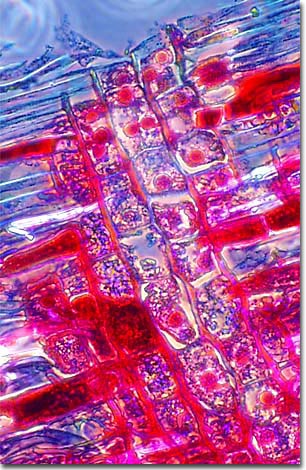Phase Contrast Image Gallery
Wheat Rust Spermogonia
Wheat rust is a common and serious disease, reducing crop yields both in the United States and in other wheat-growing areas of the world. The photomicrograph below is a phase contrast image of a stained thin section of wheat showing wheat rust spermogonia.

The disease is caused by a parasitic fungus and can affect both the leaf and stem of wheat plants. In individual fields, it accounts for crop losses ranging from trace amounts to as much as 40% when weather conditions are favorable for fungus growth. Rust infections usually appear as yellow, orange, red, rust, brown, or black powdery pustules on leaves, young shoots, and fruits.
The fungus affecting the plants produces two types of fruiting bodies during its life cycle, aecia and pycnia. These structures produce different types of spores, aeciospores and pycniospores, which are transmitted from one plant to another by the wind. The pycniospores parasitizes wheat while the aeciospores can infect other plants.
BACK TO THE PHASE CONTRAST GALLERY
